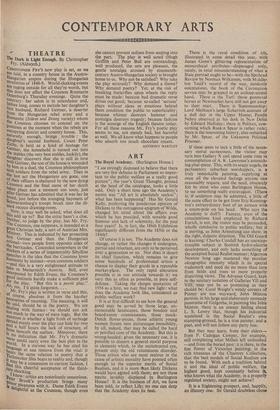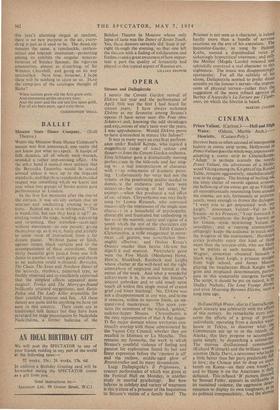ART
The Royal Academy. (Burlington House.) "I AM strongly disposed to believe that there are very few debates in Parliament so impor- tant to the public welfare as a really good picture"; the year's Great Thought, printed at the head of the catalogue, looks a little odd. Only a short time ago the Academy's motto was "All art is absolutely useless"; what has been happening? Has Sir Gerald Kelly, preferring the ponderous opinion of Dickens to the outrageous epigram of Wilde, changed his mind about the affairs over which he has presided, with notable good humour and lack of solemnity, for the pa4 four years? Is, in fact, the 186th Exhibition significantly different from the 185th or the 184th?
Of course it is not. The Academy does not change, or rather the changes it undergoes, partial and reluctant, are only to be perceived over a generation or so. Nor does it desert its chief function, which remains to give some hundreds of professional artists a chance to display their goods in a reputable market-Ace. The only rapid alteration possible is in our attitude towards it: we vary this as often as possible, in pure self- defence. Taking the chosen quotation of 1954 as a hint, we may find new light: what does the Academy look like, considered as public welfare work?
It is at first difficult to see how the general good may be served by those large, un- memorable landscapes, those boudoir and board-room countenances, those mock- Dutch flower-pieces, those athletic young women frozen into picturesque immobility, by all, indeed, that may be called the hard or petrified core of the Academy. But this is wrong-headed; given the necessary cue, it is possible to discern a general moral purpose in elements which, to the uninstructed eye, present only the old voluminous disorder. Those critics who are most zealous in the cause of artistic morality have pointed often enough to the superior merits of- Social Realism, and it is more than likely Dickens would have agreed with them; are not these merits lavishly displayed in Burlington House? It is the business of Art, we have been told, to reflect Life; no one can deny that the Academy does its best. There is the royal condition of life, illustrated in some detail this year, with James Gunn's glittering representation of monarchical attributes—disparaged only, surely, in total misunderstanding of what a State portrait ought to be—with the Spithead Review by Norman Wilkinson, with Middle- ton Todd's record of the way, modestly ostentatious, the book of the Coronation service may be grasped in an archiep.scopal hand. There is the Turf: those gunmetal horses at Newmarket have still not got away to their start. There is Statesmanship: Lord Methuen's large Sickertish account of a dull day in the Upper House; Pandit Nehru observed at his desk in New Delhi by Edward Halliday; there is Politics, con- cerning which Rusk:n Spear is rather rude; there is the interesting history, also remarked by Mr. Spear, of the Unknown Political Prisoner.
If these seem to lack a little of the neces- sary moral earnestness, the visitor may turn into Gallery X and spend some time in contemplation of A. K. Lawrence's astonish- ing altar-piece. This, with its soapy angels, its perfunctory suburban worshippers, is a truly remarkable painting, supplying at once all the elevated feelings anyone can reasonably require, and the need, obscurely felt by most who enter Burlington House, to see something really extravagant. (There is, if sculpture may be admitted, a little of the same effect to be got from Eric Kenning- ton's extraordinary bust of an airman with a totem-pole on his head. Who says the Academy is dull?) Fantasy, even of the conscientious kind employed by Richard Eurich, is not, the visitor may be persuaded, wholly conducive to public welfare; but it is moving, as John Armstrong can show, in the right, didactic direction. The Old Guard is learning: Charles Cundall has an unexcep- tionable subject in Scottish hydro-electric development, and only lacks something of the accepted Social Realist manner; Algernon Newton long ago mastered the peculiar oleographic intensity which is its special trademark and need do no more than turn from fields and trees to more properly dispiriting views. The Advance Guard, kept in the sanitary isolation of Galleries VII and VIII, may not be so promising as they should be: Carel Weight's windy corners of Putney are too wayward, John Minton persists, in his large and elaborately unsteady panorama of Golgotha, in painting like John Minton, there is an uneasy feeling about L. S. Lowry that, though his industrial wasteland is the Social Realist's own stamping-ground, he is a true painter, and a poet, and will not follow any party line.
But they may learn, from their elders—. from F. Cadogan Cowper, for example, still completing what Millais left unfinished —and from the buried past: it is there, in the fine flower of Victorian painting, in the rich treasures of the Chantrey Collection, that the best models of Social Realism are to be found. With such a tradition behind it and the ideal of public welfare, the highest good, kept constantly before it, who knows what the Academy, in a properly regulated society, might not achieve? s year's alarming slogan at random, there is no new purpose in the air, every- thing is just as it used to be. The Academy remains the same, a ramshackle, untheo- retical and tolerant institution—permitting among its exhibits the singular noncon- formism of Stanley Spencer, the vigorous amateurism, almost as disturbing, of Sir Winston Churchill, and going on its way untroubled. Next time, however, I hope there will be nothing to scare us so. Have the comp:lers of the catalogue thought of Blake?
When nations grow old the Arts grow cold, And commerce settles on every tree; And the poor and the old can live upon gold, For all are born poor, aged sixty-three.
CHRISTOPHER 'SMALL











































 Previous page
Previous page